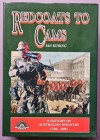Redcoats to Cams: A History of Australian Infantry 1788–2001
Written by: Ian Kuring,
Australian Military History Publications, Loftus, NSW, 2003,
ISBN: 9781876439996, 572pp.
Reviewed by: Alan Ryan, Senior Research Fellow, Land Warfare Studies Centre
Although this book will not be available until just before Christmas, its value to the Army is such that it is worth providing an advance review. The reviewer has been fortunate enough to receive the page proofs of the book and has no hesitation in recommending the book to all students of Australian military history. Given the central role played by the infantry in almost every conflict in which we have been involved, there has never been an exhaustive history of the corps. This book rectifies that deficiency admirably. The product of extensive research and detailed personal knowledge, the book is a complete account of where Australian infantry have served, their exploits, and how they were organised and equipped. Perhaps more importantly, it charts the evolution of infantry training, tactical doctrine and operating methods. Many readers, including infantrymen, will be surprised to learn of the extraordinary advances in the functions and capabilities of infantry in living memory.
Extensive annexes, diagrams and photographs back up this book. These resources provide a relief from the niggardly publishing standards of many commercial publishers. This book is the product of a lifelong passion—and it shows. The author’s own life experience reflects part of the infantry corps’ own history; Ian Kuring served as an officer and warrant officer in South Vietnam and later in Somalia. As a long-time curator of the Infantry museum at Singleton and service with the Army History Unit, Kuring is definitely one of the guardians of the history of the infantry ‘tribe’.
This valuable study, however, is not a light read, or one of those regimental-style histories that revel in anecdotes but lack substance. This is a serious, though very readable, reference work that can be dipped into for pleasure, but which will find a place on the shelf of anyone who conducts research into the evolution of our Army. There is nothing that you might want to know about Australian infantry that will not be found in the pages of this rather hefty volume. Infantrymen will want to have this book because, unless they know where they have come from and the changes that they have already made, they are unlikely to discern where they are going. Those who are involved in determining the future structure, roles and functions of the infantry battalion are already using it as a resource. It appears likely that this book will find its way into more than a few socks this Christmas and it is well recommended as a sound investment for those who will pursue their careers with the ‘queen of the battlefield’.


